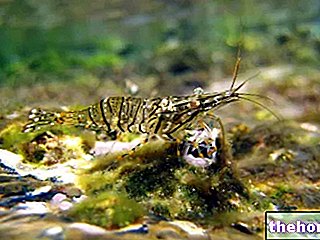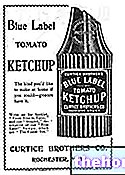What is Cremor Tartrato?
The cremor tartrate (or Cream of tartar) - chemically known as potassium bitartrate and also known as potassium acid tartrate - is the potassium salt of tartaric acid (a carboxylic acid).

Above: cremortartaro crystals in an empty wine bottle. Below: chemical formula of potassium bitartrate. From https://en.wikipedia.org
It has the chemical formula KC4H5O6 and constitutes a residual by-product in the winemaking process.
Training in Beverage and Food
The cremor tartrato crystallizes inside the barrels or bottles during the fermentation of the must and / or the aging of the wine, falling to the bottom in the form of a colorless, odorless and tasteless sand.
Crystals (commonly called "wine diamonds") are formed mainly in bottles stored at temperatures below 10 ° C and rarely dissolve again in the drink; in wines that mature in a horizontal position, the crystals are deposited on the cork (probably, in the “classic method” of vinification they are eliminated thanks to the “disgorgement” maneuver).
We remind you that the presence of cremor tartrate inside the wine is an indicator that it has not undergone a purification of a chemical nature.
In addition to wine, crystals are also formed in fresh grape juice which has been cooled or left to rest.
In order to avoid the precipitation of the crystals in the grape juice to be preserved (in the short term in the refrigerator or pasteurizing it) or in the jam, or in the jelly, or in the sugoli or in the Sicilian mustard, the grape juice should be cooled for about 12 hours ( promoting crystallization) and then filtered with two layers of gauze. Sometimes, the crystals remain attached to the surface of the cooled container (during pouring) making filtering unnecessary.
The raw form of cremor tartrate (known as beeswing) can be collected and purified to obtain a white and odorless acid powder, used in various culinary or domestic purposes that we will expose in the next chapter.
Uses
In Foods
In food, cremor tartrate is used for:
- Stabilize the egg whites by increasing their volume and heat tolerance
- Stabilize the whipped cream while maintaining its consistency and volume
- Anti-caking and thickener
- Prevent crystallization of sugar syrups
- Reduce the color loss of boiled vegetables
Additionally, cremor tartrate is used in:
- Chemical yeast, as an acidic ingredient to activate bicarbonate
- Salt without sodium, in combination with potassium chloride.
A similar acid salt, the sodium acid pyrophosphate, can be confused with cream of tartar because (in chemical yeast) it performs the same function.
Home use
Cremor tartrate can be mixed:
- to an acid, such as lemon juice or white vinegar, to produce a metal polishing detergent such as brass, aluminum or copper;
- simply with water for other cleaning applications, such as removing “light spots” from porcelain.
Sometimes, this mixture is mistakenly made with vinegar and sodium bicarbonate (baking soda) which actually react by neutralizing, creating carbon dioxide and a sodium acetate solution.
Cremor tartrate was often used in traditional dyeing, in which the complexing action of tartrate ions regulates the solubility and hydrolysis of mordant salts such as tin chloride and of alum.
If mixed with hydrogen peroxide, forms a paste that can be used to remove rust on some tools, especially hand files. The paste should be applied to the tool, left to act for a couple of hours and washed with a solution of sodium bicarbonate and water. Finally, it is rinsed again, dried and a little oil applied to prevent further oxide formation.
Medical Uses
Cremor tartrate was used as a purgative. On the other hand, this application is to be considered quite risky, since an excess of potassium in the blood (called hyperkalemia) causes very serious heart failure and, in some cases, fatal.
It is true that, if the renal system works perfectly, the onset of hyperkalemia is rather unlikely; however, since it is not always said that the human organism is in homeostasis and in perfect health, the use of cremor tartrate as a laxative it is to be considered obsolete.
Uses in Chemistry
Cremor tartrate is considered by the NIST (National Institute of Standards and Technology) to be the primary reference standard for the buffer solution (pH buffer: aqueous solution consisting of a mixture of weak acid and its conjugate base, or vice versa).
With an excess of salt in water, a saturated solution is obtained at a pH of 3.557 at 25 ° C. When diluted in acid, cremor tartrate dissociates into acid tartrate and potassium ions.
Before using cremor tartrate as a standard, it is recommended to filter or decant the solution at a temperature between 22 and 28 ° C.
The "pearl ash" can be obtained from the "ignition of the cremor tartrate. This process is now obsolete but yields an" excellent quality of "potash" (potassium carbonate, for the artisanal production of soap and glass) through the extraction of starting from the ash of wood or other plant components.




























